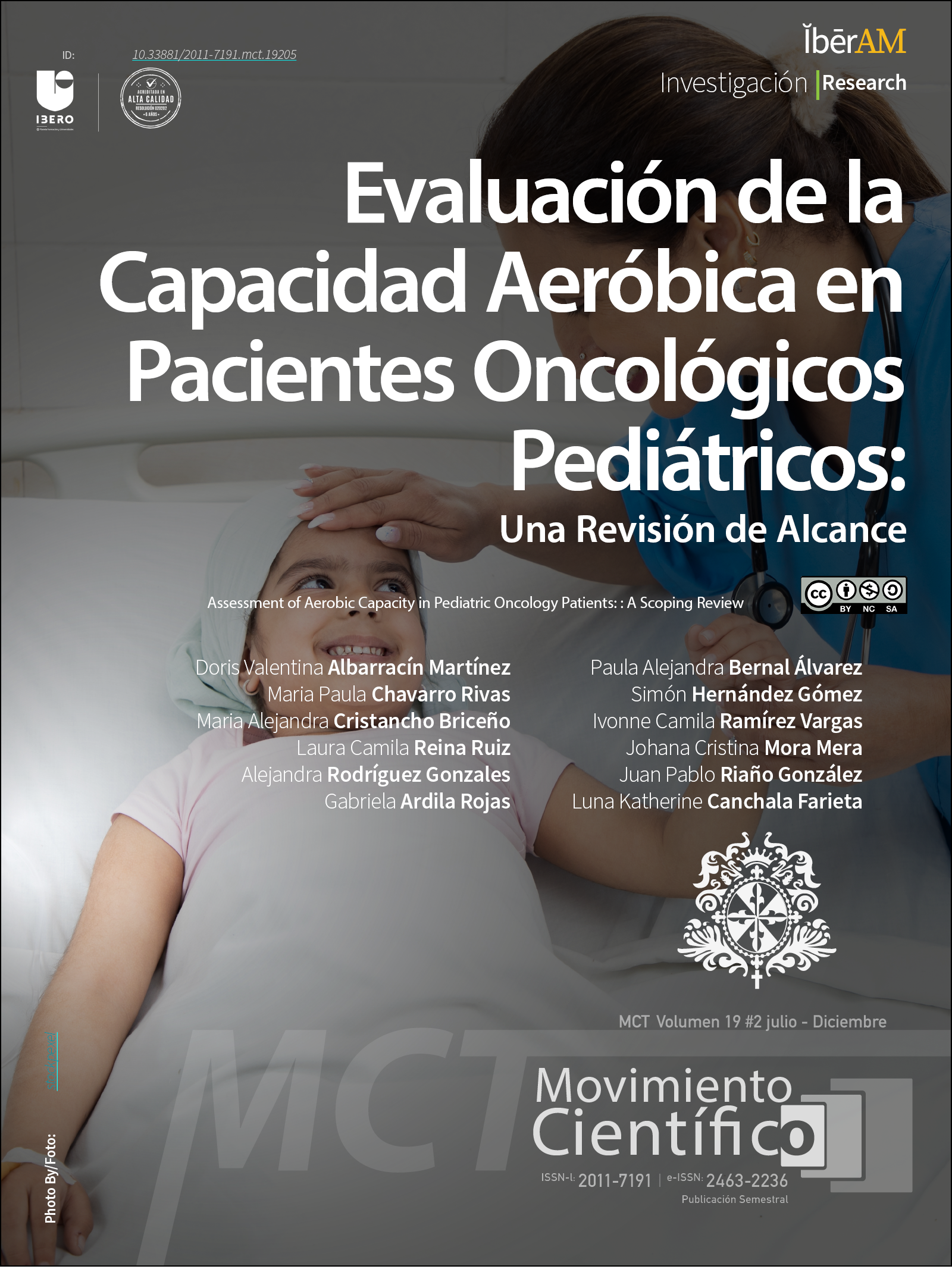Assessment of Aerobic Capacity in Pediatric Oncology Patients:
Evaluación de la Capacidad Aeróbica en Pacientes Oncológicos Pediátricos: A Review of the Scientific Literature
Main Article Content
Aim This study aims to conduct a comprehensive review of the scientific literature to identify and evaluate available instruments for measuring aerobic fitness in pediatric cancer patients or cancer survivors. Validated instruments with a high level of evidence are selected for implementation in this population. Materials and methods
The search for articles was conducted in various databases, including PubMed, PeDro, ScienceDirect, Google Scholar, Hindawi, and Scielo, covering publications between 2018 and 2023. Specific descriptors related to the pediatric population, cancer, exercise, and aerobic capacity were used. Studies with a level of evidence greater than 2+ according to the SIGN classification were included. The focus was on assessing aerobic capacity using reliable and validated instruments. Results The review compiled information on several aerobic fitness measurement instruments in pediatric cancer patients. These included the 6-Minute Walk Test, the 1-Minute Sit-to-Stand Test, the 2-Minute March Test, the Cardiopulmonary Exercise Test, and the Chester Test. Most of these instruments demonstrated robust psychometric properties, with reliability coefficients ranging from 0.80 to 1, reducing the risk of error in the results, and validity levels ranging from acceptable to good (0.70–0.95). Conclusion This article highlights the importance of evidence-based practice in physical therapy, focusing on assessment as a starting point for therapeutic intervention. It provides a compilation of validated instruments for assessing aerobic capacity in pediatric oncology patients, allowing practitioners to select and apply the most appropriate measures based on each patient's clinical and contextual conditions. This approach contributes to more effective and personalized interventions in oncology treatment.
Publication Facts
Reviewer profiles N/A
Author statements
Indexed in
-
—
- Academic society
- N/A
- Publisher
- Bogotá: Corporación Universitaria Iberoamericana
Article Details
Bennett, H., Parfitt, G., Davison, K., & Eston, R. (2016). Validity of Submaximal Step Tests to Estimate Maximal Oxygen Uptake in Healthy Adults. Sports Medicine, 46(5), 737-750. https://doi.org/10.1007/s40279-015-0445-1
Blais, S., Berbari, J., Counil, F.-P., & Dallaire, F. (2015). A Systematic Review of Reference Values in Pediatric Cardiopulmonary Exercise Testing. Pediatric Cardiology, 36(8), 1553-1564. https://doi.org/10.1007/s00246-015-1205-6
Bohannon, R. W., Wang, Y.-C., Bubela, D., & Gershon, R. C. (2018). Normative Two-Minute Walk Test Distances for Boys and Girls 3 to 17 Years of Age. Physical & Occupational Therapy in Pediatrics, 38(1), 39-45. https://doi.org/10.1080/01942638.2016.1261981
Delgado-Bustamante, R. I., & Rodríguez-Santillán, E. (2022). Evidencia del ejercicio en el tratamiento de la fatiga relacionada al cáncer infantil. Revisión temática. Revista de Salud Pública, 24(3), 1-7. https://doi.org/10.15446/rsap.v24n3.99217
Huang, T.-T., & Ness, K. K. (2011). Exercise Interventions in Children with Cancer: A Review. International Journal of Pediatrics, 2011, 461512. https://doi.org/10.1155/2011/461512
Instituto Nacional del Cáncer. (2024, agosto 8). Fatiga y cáncer—Efectos secundarios (nciglobal,ncienterprise). Instituto Nacional del Cáncer.
Ministerio de Salud. (2021). Cáncer infantil – Herramienta Clínica Primera Infancia. https://herramientaclinicaprimerainfancia.minsalud.gov.co/informacion-en-salud-para-padres/cancer-infantil/
Labonté, J., Caru, M., Lemay, V., Alos, N., Drouin, S., Bertout, L., Andelfinger, G., Krajinovic, M., Laverdière, C., Sinnett, D., & Curnier, D. (2021). Developing and validating equations to predict V˙O2 peak from the 6MWT in Childhood ALL Survivors. Disability and Rehabilitation, 43(20), 2937-2944. https://doi.org/10.1080/09638288.2020.1725159
Mantilla Alfonso Jose Ivan. (2019, marzo 14). Instrumentos de Evaluación Fisioterapéutica en Población Adulta y Pediátrica Utilizadas en la Práctica Clínica | Movimiento científico. Movimiento Cientifíco. https://revmovimientocientifico.ibero.edu.co/article/view/mct.12202
Mizrahi, D., Fardell, J. E., Cohn, R. J., Partin, R. E., Howell, C. R., Hudson, M. M., Robison, L. L., Ness, K. K., McBride, J., Field, P., Wakefield, C. E., & Simar, D. (2020). The 6-minute walk test is a good predictor of cardiorespiratory fitness in childhood cancer survivors when access to comprehensive testing is limited. International Journal of Cancer, 147(3), 847-855. https://doi.org/10.1002/ijc.32819
NCCN Guidelines for Patients: Fatigue and Cancer. (2024).
Núñez-Cortés, R., Rivera-Lillo, G., Arias-Campoverde, M., Soto-García, D., García-Palomera, R., & Torres-Castro, R. (2021). Use of sit-to-stand test to assess the physical capacity and exertional desaturation in patients post COVID-19. Chronic Respiratory Disease, 18, 1479973121999205. https://doi.org/10.1177/1479973121999205
Organización Mundial de la Salud. (2025, febrero 4). Cáncer infantil. https://www.who.int/es/news-room/fact-sheets/detail/cancer-in-children
Padilla, J. R., Santana, E., Fiuza, C., Lassaletta, Á., Pérez, A., Ramírez, M., Madero, L., Lorenzo, R., Mojares, L. M., Lucía, A., & Pérez, M. (2013). Valoración de la capacidad funcional de niños con tumores sólidos.
Phillips, D., Tomazos, I. C., Moseley, S., L’Italien, G., Gomes Da Silva, H., & Lerma Lara, S. (2019). Reliability and Validity of the 6‐Minute Walk Test in Hypophosphatasia. JBMR Plus, 3(6). https://doi.org/10.1002/jbm4.10131
Pin, T. W., & Choi, H. L. (2018). Reliability, validity, and norms of the 2-min walk test in children with and without neuromuscular disorders aged 6–12. Disability and Rehabilitation, 40(11), 1266-1272. https://doi.org/10.1080/09638288.2017.1294208
Powell, A. W., Nagarajan, R., Mays, W. A., Chin, C., Knilans, T. K., Knecht, S. K., Amos, M. A., Gerdes, Y. M., & Ryan, T. D. (2018). Cardiopulmonary Aerobic Fitness Assessment During Maximal and Submaximal Exercise Testing in Pediatric Oncology Patients After Chemotherapy. American Journal of Clinical Oncology, 41(11), 1058-1061. https://doi.org/10.1097/COC.0000000000000422
Reychler, G., Audag, N., Mestre, N. M., & Caty, G. (2019). Assessment of Validity and Reliability of the 1-Minute Sit-to-Stand Test to Measure the Heart Rate Response to Exercise in Healthy Children. JAMA Pediatrics, 173(7), 692-693. https://doi.org/10.1001/jamapediatrics.2019.1084
Silva, M. C. M. da, Lopes Júnior, L. C., Nascimento, L. C., & Lima, R. A. G. de. (2016). Fatiga en niños y adolescentes con cáncer bajo la perspectiva de los profesionales de salud. Revista Latino-Americana de Enfermagem, 24, e2784. https://doi.org/10.1590/1518-8345.1159.27844
Sietsema, K. E., & Rossiter, H. B. (2023). Exercise Physiology and Cardiopulmonary Exercise Testing. Seminars in Respiratory and Critical Care Medicine, 44(5), 661-680. https://doi.org/10.1055/s-0043-1770362
Söntgerath, R., Däggelmann, J., Kesting, S. V., Rueegg, C. S., Wittke, T.-C., Reich, S., Eckert, K. G., Stoessel, S., Chamorro-Viña, C., Wiskemann, J., Wright, P., Senn-Malashonak, A., Oschwald, V., Till, A.-M., & Götte, M. (2022). Physical and functional performance assessment in pediatric oncology: A systematic review. Pediatric Research, 91(4), 743-756. https://doi.org/10.1038/s41390-021-01523-5
Tellez, D. (2025, febrero 14). Día mundial del cáncer infantil 2025—Cuenta de Alto Costo. https://cuentadealtocosto.org/cancer/dia-mundial-del-cancer-infantil/
Wechsler, S., Kneiss, J., Adams, B., & Wood Magee, L. J. (2022). Persistent cancer-related fatigue after breast cancer treatment predicts postural sway and post-exertional changes in sit-to-stand strategy. Rehabilitation Oncology (American Physical Therapy Association. Oncology Section), 40(4), 162-171. https://doi.org/10.1097/01.reo.0000000000000308














